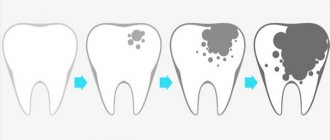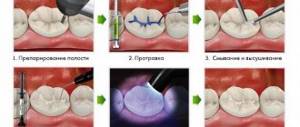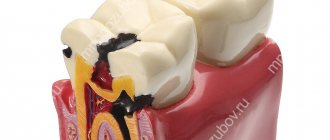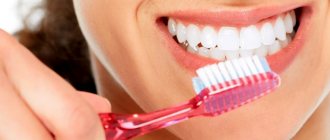Modern methods of caries treatment without drilling
Unfortunately, all treatment methods without a drill are aimed mainly at combating the superficial form of caries. Their task is to stop the carious process that has begun, and in some cases, to prevent it. Before the advent of such techniques, caries treatment was carried out only when the disease began to progress, and in the early stages it was simply not paid attention to. However, this is not the only plus. The main advantages of using these technologies are the absence of a drilling machine, as well as the ability to remove the affected tooth tissue without affecting its healthy part. So, the treatment of carious lesions without drilling is based on different principles of influence. Some of the most common techniques in the newest dental industry include infiltration, ozone therapy, air abrasion and laser dental treatment.
Infiltration method
Icon infiltration technology was invented at the Celtic University of Germany. This method of microinvasive treatment of caries refers to chemical-mechanical treatment, which completely eliminates tooth preparation - drilling, and is used only in the treatment of initial caries, initial carious lesions after using braces, as well as caries in the spot stage. The principle of operation of the method is to apply a special gel to the surface of the affected area of the tooth, which splits the enamel, after which the carious lesion is dried with 99% ethyl alcohol in combination with an air stream and impregnated with a polymer resin. The procedure protocol is clearly depicted in the figure below.
The positive aspects of this technology can be considered painless and quick (the procedure takes 15–20 minutes) removal of exclusively the affected part of the tooth. However, the method is applicable only on the smooth surface of the teeth or between them. Also, the shape of the “hole” should be ideal - with smooth edges and a wide entrance. International studies have confirmed the effectiveness of the infiltration method, which has made it possible to stop the development of caries for many years in both adult patients and children.
Types of disease
Tooth decay can begin in any area. But two types of caries are especially common - cervical and fissure.
Cervical
If the process occurs at the level of the gum or under it, the disease is called cervical caries. This is the most unpleasant case. It is difficult to diagnose, as it is often hidden behind hard plaque or under the gum.
The process of its treatment is also more difficult compared to other localizations, and the risk of tooth loss is slightly higher.
fissure
Fissures are depressions on the chewing surface. There are food particles left behind that are difficult to completely clean out at home. This leads to putrefactive processes and damage to the enamel. Therefore, this type of caries is one of the most common. Fissure sealing may be performed as a preventative measure.
Stages of the disease
They are distinguished by the degree of damage to dental tissue:
- Carious spot . This is the stage of enamel degradation without violating its integrity. It manifests itself in the appearance of a zone with a changed enamel color. The spot may be yellowish, brownish or very light in color.
- Superficial . A small depression appears and a carious hole begins to form.
- Average. The damage goes deeper. The upper part of the dentin begins to collapse.
- Deep. Having spread to the dentin area, the process progresses faster. The destruction is significant, caries can affect the pulp and periodontal tissue.
The fourth stage is the most dangerous, as it is fraught with complications such as dangerous not only tooth loss, but also purulent processes.
Primary and secondary types of caries
Primary – formed on a healthy tooth for the first time.
Secondary (return) – formed on a previously filled dental unit.
In case of relapse, a lesion may appear both on the intact part of the tooth and under the filling.
Ozone treatment method for caries
Ozone therapy was developed in England. Unlike other modern methods of treating initial caries, the ozone method is aimed at suppressing tooth-destroying bacteria and subsequent remineralization of dental tissues. But it also allows you to avoid drilling, and therefore anesthesia. In some cases, it is possible to do without a filling! The essence of the method is this: a special device converts oxygen into ozone, which instantly neutralizes carious lesions and destroys harmful bacteria that provoke the destruction of dental tissue. Then the substance “comes out” of the tooth, again being converted into oxygen. Healthy cells remain unaffected, as they are more resistant to oxidation and can withstand the effects of ozone. The procedure lasts about 20 – 40 seconds.
Who can be recommended for caries treatment with ozone? Almost any patient with the initial stage of caries, because ozone cannot cause allergic reactions, as well as irritation of the oral cavity. But if a deep carious process is observed, then you will still have to resort to drilling. In addition, ozone treatment is recommended to everyone without exception as a preventive measure for caries in adults and children. Despite all the advantages of the method, the practice of introducing ozone therapy into dental clinics in Russia is small. The reason for this is the relatively high cost of equipment. To get an idea of how ozone treatment occurs, see the figure below.
Causes of caries
The main factor in the occurrence is the bacteria Streptococcus mutans, which during their life processes produce acid that destroys the protective layer of enamel. These bacteria feed on food left on the teeth, especially sugars. That's why it's so important to brush your teeth regularly and eat less sweets.
Also, for the formation of an enamel layer of normal thickness and resistance, the digestibility of minerals is important.
The main reasons for the development of caries:
- unhealthy diet (abuse of sugars, acids, too hot or cold foods);
- poor oral hygiene;
- heredity;
- malocclusion, dental defects;
- mechanical damage to enamel;
- chronic gastrointestinal diseases;
- pregnancy, lactation period;
- ignoring preventive dental examinations.
Elimination of the main factors in combination with timely prevention will allow you to maintain dental health longer.
Air abrasive processing
The air-abrasive method involves mechanical treatment of carious lesions using special sandblasting machines, which are also used for professional oral hygiene. The idea of “knocking out” superficial caries with a stream of air containing impurities arose in the 40s in the USA. Then quartz sand was used as an abrasive (an impurity with high hardness), and later - aluminum oxide, a colorless and non-toxic substance. Flow-abrasive systems “shoot” with enough power to remove softened, caries-affected tissues without harming healthy ones. In the case of using air-abrasive treatment, the possibility of developing secondary caries is practically eliminated. The procedure is safe, painless, and does not require anesthesia when treating initial caries.
As with other methods of treating caries without a drill, the air-abrasive method does not heat the dental tissues and does not create noise or vibration. Moreover, it reduces the risk of microcracks forming, which can later cause destruction of the entire tooth. “Knocking out” with an air stream with abrasives occurs pulsed, for 5–10 seconds, which is more effective than dissection with a drill. The air-abrasive treatment method is not ideal, because in some cases it may still be necessary to clean out the caries with a drill and place only a composite filling. Sometimes this method of dental treatment is not applicable at all due to the inaccessibility of the installation tip to the affected area. Another disadvantage is the possible increase in tooth sensitivity in the future.
Minimally invasive therapy
05.03.2020
Progress does not stand still. It penetrates into all areas of science and technology. Dentistry is no exception. Specialists apply innovations in everyday practice. Thus, minimally invasive therapy in combination with leading medical practices allows you to leave the maximum possible amount of healthy tooth tissue intact. The principle of minimal penetration is otherwise called microdentistry. It offers new standards of treatment that preserve more healthy tooth structure and reduce the risk of future tooth decay.
Over the years of rapid development of the industry, new institutions have appeared, such as the Academy of Minimally Invasive Dentistry (ACAMID), Internet sites to inform doctors and patients about the successes of microdentistry. Manufacturers offer the equipment and materials most suitable for this concept. The day is not far when dentists around the world will abandon traditional treatment methods in favor of minimally invasive ones.
The air-abrasive method was recognized as one of the most successful methods for removing affected tooth tissues, compared to chemical and instrumental methods. Its essence lies in the use of specially calibrated powder supplied in a mixture with an air stream under low pressure. The Danish air-abrasive system “Sandman Futura” is considered the most effective. It uses a unique vortex spray principle. It provides precise powder delivery under physician-regulated air pressure. This method is used to treat patients of all ages: children, adolescents, adults and the elderly, and has many advantages over classical bur preparation:
- No anesthesia is required, even in most cases when treating deep caries.
- There is no vibration or pressure on the tooth tissue.
- There is no mechanical irritation causing pain.
- Tooth tissue is removed smoothly and consistently.
- The entire treatment process is visible to the naked eye of the doctor.
- There is no psychological pressure on the client, since there is no sound of the drill and no unpleasant smell.
- The processing speed is 2-3 times higher than that of a drill.
- There is no risk of overheating or hypothermia of the nerves.
- Statistics do not know cases of recurrent caries after Sandman Futura treatment.
Sandman Futura is used not only for treating cavities, but also for a number of other cases:
- Cleaning and preparation of various cavities for aesthetic restoration.
- Roughening surfaces to improve traction.
- Preparation of ceramic structures (zirconium crowns, veneers).
- Removal of old fillings, cement and composite residues.
- Removing stains and plaque.
- Removing ceramic inlays.
- Preparation of bracket systems
- Cleaning clamping tools, seals, corrosion.
Advantages of using Sandman Futura for doctors:
- The procedure is faster, easier and controlled at all stages.
- No anesthesia stage is required.
- Best preparation quality.
- Healthy dental tissues are preserved as much as possible.
- There is no heating, cooling or vibration.
- New horizons for professional growth are opening up.
Benefits for patients:
- No pain, smell or sound from the drilling machine.
- Complete psychological comfort.
- High process productivity. Treatment takes 2 times less time.
- Long warranty.
Non-drilling treatment is suitable for primary and permanent teeth. It is non-traumatic and hypoallergenic. In 89% of cases it does not require anesthesia.
Exclusively at IC "Unit". Gentle treatment without boron and pain.
Back
Laser dental treatment without a drill
Treatment of caries with a laser, in other words, laser fluorescence, as well as the above methods, implies the treatment of caries without drilling in the sense in which we are accustomed to understanding drilling and the associated discomfort.
Why does unpleasant pain occur while the drill is working? The fact is that intense heating and friction occurs between the dental drill and enamel, dentin. And to these sensations is added vibration that spreads to the dental tissues. During laser treatment, tissue heating does not occur due to the low radiation power. In addition, laser devices are 20 times quieter than a drill! In this case, the main thing is not to accidentally fall asleep in the dentist’s office. It is not without reason that this method is recommended not only for people with increased sensitivity to pain and sounds, but also for those most sensitive to the perception of external stimuli - pregnant women and children. In addition, the procedure for laser treatment of caries is absolutely sterile - the tip of the installation does not come into contact with the teeth. The laser performs cavity preparation by selectively affecting caries, or, more precisely, only tissue infected with caries. The impact completely suppresses the growth of carious bacteria and eliminates the risk of secondary caries. At the same time, the laser method does not harm healthy teeth, and also does not lead to microcracks in the enamel. And the time spent on treating caries is reduced by about 40% compared to traditional treatment - there is no need to change attachments, and when treating superficial caries, there is no need to use anesthesia. Today, dentistry uses lasers not only as a method of treating caries, but also as a diagnostic method. The second is a significant advantage compared to X-ray diagnostics, since in the case of laser “checking” there is no radiation.
Disadvantages of treating caries without drilling teeth
- high cost of laser installation
- high demands on specialists working with lasers
- treatment requires the use of protective dark glasses by both the patient and the doctor
- glasses with tinted lenses can distort the reality and reduce the clarity of vision
- in some cases, soft tissue damage caused by lasers heals slowly and poorly
- there is also a possibility that the laser will be reflected from metal objects in the dentist's office, if they are not removed, and cause a fire
Dental treatment without drilling using folk remedies
Of course, you cannot cure caries at home. The only thing in your power is to follow measures to prevent its occurrence. In addition to simple and understandable actions for every person to maintain the health and integrity of teeth (brushing the tongue and teeth twice a day after meals and visiting the dentist once every six months), there are additional measures. These include, for example, the application of special gels that strengthen tooth enamel and saturate it with missing minerals. This helps prevent caries and its complications, but does not eliminate them. Another interesting way to treat caries at home is milk powder, used as a toothpaste substitute. Brushing with this milk powder reduces bleeding gums and reduces the risk of tartar.
Folk remedies for caries are intended to generally relieve toothache, but not eliminate its cause. To relieve pain, various alcoholic infusions of medicinal herbs are used, lotions are made and applied directly to the diseased tooth; It is also recommended to rinse your mouth with an infusion of strong tea. There is a point on the body, pressing firmly on which temporarily relieves toothache. The point is located in the area between the nose and lips. Don’t overdo it; you will still have to contact a specialist for real help in eliminating the cause of toothache. Make sure that your toothpaste contains microelements such as fluoride and calcium, and that your diet contains fewer carbohydrates and more greens, lean meats and dairy products.
Nowadays, there is a lot of debate about how to cure tooth decay without pain and fear. Technologies that can solve dental problems without the use of a drill are just beginning to appear on the Russian market. In any case, even such modern methods of caries treatment are applicable mainly in the early stages of its occurrence. If you are not eager to experience the effects of drilling with a bur, do not neglect the health of your teeth and seek help from specialists in a timely manner.











